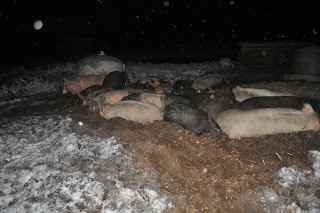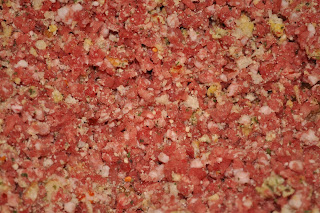I was reading the local paper on Monday, and saw this story: Fourth-generation dairy farm in county to sell off cattle, equipment. This particular farm had a manure lagoon burst earlier this year, and I mention that because it's a significant cause of this farms demise. Not the burst lagoon so much, as the uncertainty that they'd be allowed to rebuild it.
The local news media was out in force; camera crews from the three local TV stations, print reporters from the local papers, and a couple of bloggers like myself. I was there to buy equipment that I use on my farm, calf domes and maybe tractor. 70 year old dairy farm gone in a flash.
The prices received for the cows were generally higher than you would see at a typical auction. Part of this was because Bartelheimer Brothers dairy had a very good reputation for their animal husbandry, and had been in business for 70 years. Unlike the auction where you're getting the animals that the farmer wanted to sell, all of the animals were for sale here. The silver, gold and platinum -- every animal was for sale. And the bidders recognized that and paid a 15-20% premium over equivalent auction prices. It's rare that you get to see appreciation in concrete form; and for farmers, where every dollar is dear, the tribute was nice.
excerpts of conversations:
"...yes, my girl goes to school with one of the grandkids. I saw her over there crying, I didn't know what I could say..."
"...what's he going to do with the land? there's 500 acres here; can anyone else make a profit if they buy it or lease it? it'd be worth a couple of million and the interest on that sort of..."
The
"...yea, it was the manure lagoon. To rebuild it they'd have to spend a lot of money on seismic tests and there's no guarantee that they'd get the permit even if they did that, and milk prices..."
"Hi Bob! buying today?"
Most of the people standing in the rain were in their work clothes, boots and hats, and most of them knew each other. You'd see small groups form up, as each weighed the value of this or that item sold, or whether it was a good deal, or commiserated with a glance around that the last two years were tough. "...yea, the market for cheese and export just dried up, and..."
the hundreds of people followed the auctioneer around, as each item was sold. There was no overt expressions of joy; most of the buyers knew this family directly, but reputation or in person, and a "bargain" wasn't really something to crow about. But farmers are a taciturn bunch even in the best of circumstance; I think that it's the stoic nature of America farmers that make protests about food prices as are common in Europe something that would be hard to imagine here. I'm reminded a bit of a lyric from an offspring song, "self esteem". "The more you suffer, the more you show you really care, yea, yea yea!"
After the bidding was done as people settled their bills, small groups socialized. Sometimes this sort of event is the only time that these guys see their peers. So much of their work is done surrounded by acres of space and hundreds of animals.
Western Washington drinks a lot of milk and eats a lot of ice cream. When we have a regulatory environment where a long-standing business with a good reputation and decades of experience can't be certain to be allowed to continue, it's a pretty significant problem. Sure; I'm not a big fan of manure lagoons, but that's the current method of dealing with the manure -- and what this means is that the same production will just be shifted to some other area -- probably some other state. Local food means that we should be prepared to see it produced, and deal with the consequences of that production. Our current environmental stance is hypocritical. The same stuff goes on in Wisconsin and Iowa and Indiana and Ohio; and milk and products shipped in from there are purchased without batting an eye. I believe that we need to be more honest with ourselves. Next time you eat ice cream, or butter, or milk, or bake a cake or do any of the other myriad things we do with dairy products, think about this. I count this farm as killed by NIMBY.
What to do
For farmers or people thinking about starting a farm
If you're a farmer or considering becoming a farmer, consider joining your local farm bureau; yes, they are reasonably radical, but they will also keep you aware of the issues facing agriculture in your area and in the nation. This particular farm had no direct-to-customer retail that I could see, and I haven't seen many profitable farms that don't have at least some direct-to-consumer sales. Strongly consider selling at least half of your production direct to consumers as a basic goal in your business plan. Wholesale means you'll get what the average farmer gets; $0.05 per retail dollar for farm goods, and that just sucks.
For consumers who want to help keep their food local
If you're a consumer, consider directing 10% of your food dollars to a farmer you know the name of. If you know their name you're buying direct, and that means that more of your food purchase dollars are going direct to the people who produce it, and that helps them stay in business and local, too. One site I recommend is eatwild . I like eatwild because it will put you in touch with farmers that maybe haven't made the marketing leap to get into a farmers market, or a direct-sale website, and those are the folks that are usually closest to the edge -- they appreciate your business all that much more.























































